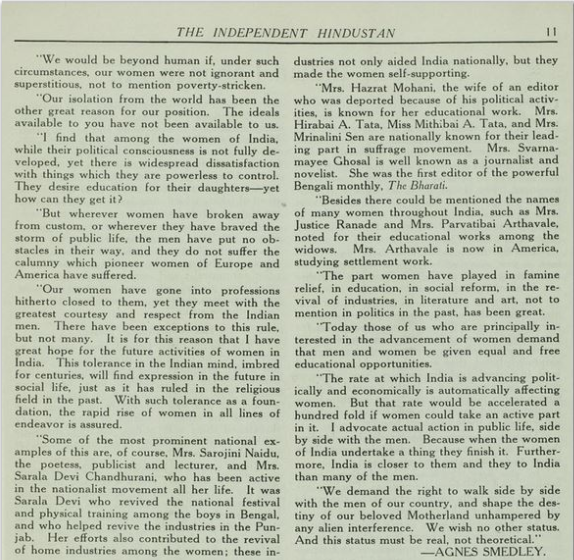Introduction
Throughout the 1920s, there were many achievements for women’s rights, beginning with the nineteenth amendment in 1920. This was the beginning of the evolution of women’s roles. While many are familiar with the gender roles that were historically known to be strict, other countries, such as India, had much worse gender stereotypes and gender violence. Women were heavily oppressed and were discouraged from fighting for their rights. This document, “Women and New India,” is an article that was written by Agnes Smedley, an American journalist, quoting from her interview with Lila Singh, a women suffragist in India on women’s roles in the 1900s. This document is important in the greater context of understanding the 1920s, as the concept of women’s rights in this time period tend to be discussed only in the light of the United States, however, the oppression of women occurred in many other countries, and at times, were treated much more poorly.
Record of “Women and New India”


Transcription
Women and New India (An Interview with Mrs. Lila Singh, a Suffragist of India) "The women of India are part and parcel of Hindustan; [term used to reference the modern day India] they retain the traditions and customs of India, and they are the greatest potential forces in the struggle for freedom through which India must and is passing." These are the words of Mrs. Lila Singh, [women suffragist in India] of Behar, India, who toured the United States in company with her husband, Mr. Deep Narayan Singh. [Mr. Singh was an Indian politician and served as the Chief Minister of Bihar] While in this country Mrs. Singh carefully studied the activities of American women. She met women of every walk of life and by her own charming personality, her perfect command of English and her strong and determined character, made a good many friends. Mrs. Lila Singh was the first woman student in a college exclusively meant for men. She obtained the degree of Master of Arts in Philosophy and Literature with honors from the Calcutta University. Her father, Mr. T. N. Palit, before his death bequeathed his entire fortune for the promotion of education. He founded Bengal Technical Institute affiliated with the National Council of Education, and College of Science affiliated with the Calcutta University. Her husband, Mr. Deep Narayan Singh, is a publicist and promoter of education. He is the founder of T. N. College at Bhagalpur, Behar, India. Speaking at greater length upon the women of India, Mrs. Singh declared that although education is available to but a few, yet everywhere and with almost all Indian women, there is a vague, or a more clearly-defined unrest because of their lack of opportunity, and because of their suffering. "Those who are more conscious of India's position in the world," she continued, "realist that at the bottom of these evils is the denial of education to the people in general, and to women more particularly. The reasons for that denial are deeper and more fundamental still; they are political and economic in origin. "I admit our social evils. I am not one of those persons who would build a plea upon falsehoods. But the very fact that the social evils exist is the strongest possible argument for a complete political and economic change, because these conditions are but effects of a system. The same situation existed in Europe and America up to a short time ago, comparatively speaking. And the women of Europe and America would be in the same position as the women of India if the same political system prevailed in those countries. "I will give but one example, without comment, to show what I mean. I will quote cold figures, [essentially meaning statistics or exact numbers] which are not of my own composition. These figures are of military expenditure in India, and of money spent on education by the present government: "In 1915-16, $132,000,000 was spent on the military. "In 1916-17, $148,000,000 was spent on the military. "In 1917-18, $180,000,000 was spent on the military. "In 1919-20, $346,000,000 was spent on the military. "In 1920, the same year when $346,000 was spent on militarism from the revenues of the Indian people, we tried to secure an appropriation for $76,000,000 for primary education - education just for the first few grades. No money could be found! India was poor - the budget did not provide for it! Yet, in that same year, an extra $80,000,000 was needed for additional military expenditure to carry on a war with Afghanistan and in the Near East. And immediately the $80,000,000 was forthcoming! "Of the entire Indian budget, 63% is spent on military expenditures, and but 6% on education. [page 2] "We would be beyond human if, under such circumstances, our women were not ignorant and superstitious, not to mention poverty-stricken. "Our isolation from the world has been the other great reason for our position. The ideals availble to you have not been available to us. "I find that among the women of India, while their political consciousness is not fully developed, yet there is widespread dissatisfaction with things which they are powerless to control. They desire education for their daughters - yet how can they get it? "But wherever women have broken away from custom, or wherever they have braved the strom of public life, the men have put no obstacles in their way, and they do not suffer the calumny which pioneer women of Europe and American have suffered. "Our women have gone into professions hitherto closed to them, yet they meet with the greatest courtesy and respect from the Indian men. There have been exceptions to this rule, but not many. It is for this reason that I have great hope for the future activities of women in India. This tolerance in the Indian mind, imbred for centuries, will find expression in the future in socail life, just as it has ruled in the religious field in the past. With such tolerance as a foundation, the rapid rise of women in all lines of endeavor is assured. "Some of the most prominent national examples of this are, of course, Mrs. Sarojini Naidu, [first Indian woman to become an Indian State Governor and President of the Indian National Congress] the poetess, publicist and lecturer, and Mrs. Sarala Devi Chandhurani, [a founding member of the Indian National Congress] who has been active in the nationalist movement all her life. It was Sarala Devi who revived the national festival and physical training among the boys in Bengal, and who helped revive the industries in the Punjab. Her efforts also contributed to the revival of home industries among the women; these industries not only aided India nationally, but they made the women self-supporting. "Mrs. Hazrat Mohani, the wife of an editor who was deported because of his political activities, is known for her educational work. Mrs. Hirabai A. Tata, Miss Mithibai A. Tata, and Mrs. Mrinalini Sen are nationally known for their leading part in suffrage movement. Mrs. Svarnamayee Ghosal is well known as a journalist and novelist. She was the first editor of the powerful Bengali monthly, The Bharati. "Besides there could be mentioned the names of many women throughout India, such as Mrs. Justice Ranade and Mrs. Parvatibai Arthavale, noted for their educational works among the widows. Mrs. Arthavale is now in America, studying settlement work. "The part women have played in famine relief, in education, in social reform, in the revival of industries, in literature and art, not to mention in politics in the past, has been great. "Today those of us who are principally interested in the advancement of women demand that men and women be given equal and free educational opportunities. "The rate at which India is advancing politically and economically is automatically affecting women. But that rate would be accelerated a hundred fold if women could take an active part in it. I advocate actual action in public life, side by side with the men. Because when the women of India undertake a thing they finish it. Furthermore, India is closer to them and they to India than many of the men. "We demand the right to walk side by side with the men of our country, and shape the destiny of our beloved Motherland unhampered by any alien interference. We wish no other status. And this status must be real, not theoretical." - AGNES SMEDLEY
Analysis
While it was not until the late 1970s that women in India were gaining the confidence to speak out against the mistreatment, violence, and oppression of women, the 1920s were still an important time in India. It was the beginning of a movement that within the next fifty years would snowball into something greater. As written in the article by Ms. Agnes Smedley, it was during these recent times that women were celebrating many firsts. The first section of the document, where Smedly writes, “…they [women] retain the traditions and customs of India, they [women] are the greatest potential forces in the struggle for freedom through which India must and is passing,” is extremely powerful. As mentioned earlier, this marked the early stages of the women’s rights movement as they were trying to find their footing in society and how to gain independence.
To learn more about the achievements of women during the 1920s and to get an understanding of women’s suffrage from the perspective of the United States, you may read another post I wrote titled, “Ida B. Wells’ Role in Women’s Suffrage.”
References
Banka, Neha. “Sarala Devi: From Tagore’s Family, a Leading Light of the Swadeshi Movement.” The Indian Express, March 8, 2020. https://indianexpress.com/article/lifestyle/sarala-devi-tagore-family-swadeshi-movement-bengali-revolutionary-6302759/.
“Sarojini Naidu.” Encyclopædia Britannica. Encyclopædia Britannica, inc. Accessed May 12, 2021. https://www.britannica.com/biography/Sarojini-Naidu.
The Swaddle. “A Brief History of Indian Women Protesting Gender Inequality.” The Swaddle, October 19, 2020. https://theswaddle.com/a-brief-history-of-indian-women-protesting-gender-inequality/.
“Women and New India, September 1920.” Jane Addams Digital Edition. Accessed May 12, 2021. https://digital.janeaddams.ramapo.edu/items/show/28691.

Angelina Farallo is a Law and Society Major at Ramapo College of New Jersey. Ever since she was in elementary school, history has always been her favorite subject. During her studies at Ramapo College, she has studied how the modernization of technology has affected various industries such as the law, and in this case history which is what drew her to take this Digital Humanities course.
